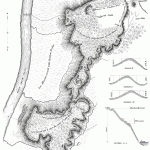
Fort Ancient. A prehistoric Indian fortification in Warren County, Ohio. It is situated on a headland, from 260 to 280 ft high, which projects from a plateau and overlooks the E. bank of Miami River. The slopes are mostly steep and in several places precipitous. The place is naturally a strong one, the elevated area being flanked by two ravines that approach each-other some distance back from the point of the bluff, forming a peninsula of this front part with a narrow isthmus behind it. This divides the fort into two unequal portions, the smaller one embracing the peninsula known as the “Old Fort,” the other, known as the “New Fort,” extending back and eastwardly on the plateau to a second but wider neck of land. The total area is estimated at about 100 acres. The wall, which is chiefly of earth, follows closely the zigzag course of the bluff, except where it crosses the level neck of land in the rear of the fort. The work has been often described and figured, the first notice and plan being that given in the “Portfolio” 1 , from which Atwater’s plan and description 2 appear to have been in large part copied. About 20 years later a survey was made by Locke, whose description and plat appear in Trans. Assn. Am. Geologists, I, 1843. Locke’s plat was copied by Squier and Davis, and is the one from which most subsequent figures have been taken; it is accurate in the main, but the elements have somewhat changed the configuration in subsequent years, additional ravines having been formed by water breaking through the wall at certain points. Evidences of wearing are observable at some of the ravines crossed by the wall, and a few of the smaller gullies appear to have been worn since the wall was built, although in most cases the adaptation of the wall to the slopes show that these existed when it was erected. That gaps were left in the wall at the bottom of the few deep ravines that it crosses is evident from the form of the wall at these points, but nothing remains to indicate how these gaps were closed in case of attack. Although the wall is built chiefly of earth (mostly of clay) cast up from an inside ditch, it is partially under laid at numerous points with stone. The total length of the wall, following all the bends, is 18,712 ft, or a little more than 3 m.; the height varies from 6 to 10 ft, except across the neck at the back of the fort where it reaches 18 or 19 ft. The solid contents probably do not exceed 3,000,000 cu. ft.
That Fort Ancient, so called, is a work of defense is evident from its character and situation, exhibited especially by the different methods adopted for defending its more vulnerable points. The only level approach was at the rear, which was protected by a high wall. On the north the points more easily approached are usually narrow, sloping ridges, generally crossed at the upper terminus by a wall of ordinary height, the ridge immediately outside being cut down several feet in order to present a steep slope corresponding to the outer slope of the wall. On the other hand, where similar ridges form approaches from the s., and at some other points, the defenses are formed by raising the wall considerably above the normal height, The most vulnerable point appears to be at the isthmus separating the two forts, where the opposite walls have their nearest approach. Here a short space was undefended, though the ascent is by no means difficult. A short distance east of the posterior wall of the new fort are two small mounds, a short distance apart, from each of which extends a low wall, or road as Atwater terms it, elevated about 3 ft, running nearly parallel about ¼ m., and forming an irregular semicircle about another small mound. A part of the area between these walls was paved with flat stones, remains of which now lie at a depth of 2 ft in the soil. Several small mounds and a number of stone graves which contained human remains were within the fort; these were explored by Moorehead, but nothing of special interest was found except the human remains. The greater portion of the area included in this enclosure is now the property of the State of Ohio and has been made a reservation under the care of the Ohio Archaeological and Historical Society. The first purchase was made in accordance with an act of the legislature, Apr. 28, 1890, and the second purchase in pursuance of the act of Apr. 16, 1896.
For further information on Fort Ancient see, in addition to the works cited:
- Ancient Skill in Fortification
- Allen, Prehistoric World, 1885;
- Drake, Pictures of Cincinnati, 1815;
- Howe, Historical Collections of Ohio, 1898;
- MacLean, Mound Builders, 1879;
- Moorehead, Fort Ancient, 1890;
- Peet in Am. Antiq., Apr., 1878;
- Shepherd, Antiquities of Ohio, 1887;
- Thomas in Science, v, Dec. 10, 1886.
Citations:

